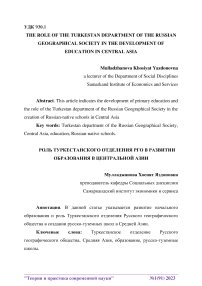The role of the Turkestan department of the Russian geographical society in the development of education in Central Asia
Автор: Mulladzhanova Kh.ya.
Журнал: Теория и практика современной науки @modern-j
Рубрика: Основной раздел
Статья в выпуске: 1 (91), 2023 года.
Бесплатный доступ
This article indicates the development of primary education and the role of the Turkestan department of the Russian Geographical Society in the creation of Russian-native schools in Central Asia
Turkestan department of the russian geographical society, central asia, education, russian-native schools
Короткий адрес: https://sciup.org/140296947
IDR: 140296947 | УДК: 930.1
Текст научной статьи The role of the Turkestan department of the Russian geographical society in the development of education in Central Asia
After the aggressive campaigns of Tsarist Russia in Central Asia, one of the main issues of the tsarist government was education and enlightenment, in the spirit of imperial ideology. One of the reformers in the development of education in Turkestan was the Governor-General K.P. Kaufman. Projects and plans for organizing school education in Turkestan were reflected in the ideas of K.P. Kaufman, N.I. Ilminsky, N.P. Ostroumov and other Turkestan reformers. Kaufman in every possible way attracted the Russian public and scientific societies to the idea of developing school education in the Turkestan region.
For the further development of education, the Turkestan department of the Russian Geographical Society played a huge role. Determining the historical role of the Turkestan department in the development of scientific thought in the Turkestan region, its exceptional influence on the development of education and culture should be noted.
In the Turkestan region, along with other scientific and public institutions, the administration of the Turkestan department was engaged in the development of methodological educational literature on the geography and history of the Turkestan region, organized open general meetings of the Turkestan department for teachers of schools and gymnasiums.
Initially, Russian-native schools of primary education in the Turkestan region were opened to educate children of the local population of non-Russian nationalities. Under the office of the Turkestan Governor General, a special commission was organized with the aim of compiling a unified curriculum in local and Russian classes for all Russian-native schools in the region. It was valuable to familiarize with the values of European Russian culture, bearing in mind the training of them in the subsequent officials of the lower level of the regional administration. The first school was opened in 1884 in Tashkent.
This school provided for a four-year period of study, the age ranged from 7 to 17 years. At first, boys and young men were trained, later two-class female Russian-native schools were opened. Students in these schools were divided into classes - Russian and native. Russian teachers worked at the school, as a rule, they were graduates of the Tashkent Teachers' Seminary who taught Russian and arithmetic at the school and teachers of the local nationality - a mullah who taught the local language, Arabic and writing, taught the basics of the Muslim faith.
The first two hours of the class were conducted by a Russian teacher who was engaged in reading, writing and just talking with students in Russian, and the second two hours were classes in the local language
In Russian-native schools, unlike local maktabs, classes were held according to certain programs. The lessons were held according to a clearly specified schedule with a specified duration of each lesson. Classes ran from August 1 to June 1 next year. Non-school days were also determined during the academic year. This is evidenced by the report card of non-school days in the Russian-native schools of the Turkestan region. Schools consisted of three divisions of classes, and the school week lasted six days. Russian programs did not correspond to local conditions and lifestyle
The task of the Turkestan department was to unite all scientists and teachers associated with the teaching of academic subjects on local material to prepare special educational literature and programs. These circumstances forced to modify the curricula in relation to local conditions. It should be noted the important role of the Turkestan department in the creation of scientific literature, as well as textbooks on geography and local history for secondary schools.
The implementation of educational programs in Turkestan contributed, on the one hand, to the creation of a dialogue between scientists, public figures and teachers of the Turkestan region on issues of cultural, scientific and educational spheres, on the other hand, created the ground for the development of secondary and higher education.
Thus, education became a solid foundation in the introduction of Russian literacy and culture in the Turkestan region. It influenced the development of the scientific school, the socio-economic and cultural life of the peoples of the Turkestan region.
Список литературы The role of the Turkestan department of the Russian geographical society in the development of education in Central Asia
- B. V. Bartold "History of the cultural life of Turkestan" Tashkent. 1875.
- K. E. Bendrikov “Essays on the history of public education in Turkestan” M.: Academy of Pedagogical Sciences of the USSR. 1960. 503 p.
- S. M. Gramenitsky "Essay on the development of public education in the Turkestan region" Tashkent 1896. 50 p.
- M. F. Dumenko “Russian-native schools of Turkestan” Tashkent. Ministry of education Uz. SSR. 87 p.
- "Primary public education" - Encyclopedic Dictionary of Brockhaus St. Petersburg 1890-1907.
- A. F. Selivanov “On Russian-native schools in the Turkestan region. School education 1891.


